Back to page 1
The Design
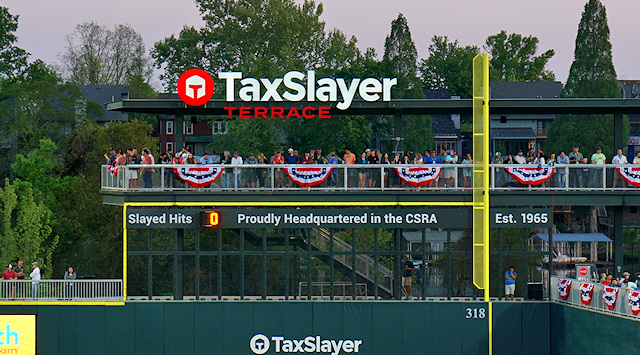 |
On Opening Night, fans examined every inch of the ballpark while walking around the 360-degree concourse. Of course, at Lake Olmstead, there wasn’t a lot to examine. Here, though, there was a seemingly endless list of fun features.
The most oohs and ahhs, however, were reserved for SRP Park’s most outstanding feature, the TaxSlayer Terrace that towers over right field. The tax-prep company that bought the naming rights is headquartered in Augusta.
From this platform, you have a spectacular view of the river and the 13th Street Bridge that crosses it.
“It’s an incredible signature feature. You see it from all around the ballpark,” noted Shultz. “On this perch, you’re either looking right down on the field or you’re looking over your shoulder at the Savannah River.
“It’s a stunning spot.” That’s putting it mildly.
Unlike at the Home Depot Clubhouse at SunTrust Park in Atlanta, you don’t need a special ticket to climb the stairs and experience this covered perch – and if you come to a GreenJackets game, it’s unimaginable that you wouldn’t check this place out. The team was even nice enough to construct a bar on this porch for patrons who want to hang around awhile.
Eiseman readily admits that the TaxSlayer porch is his favorite design element of SRP Park. “This ballpark is meant for people to mill around. We built social spaces for fans to interact with the park, and the top one is that terrace. I don’t care if the fans there even pay attention to the game as long as they are enjoying themselves and experiencing the ballpark.”
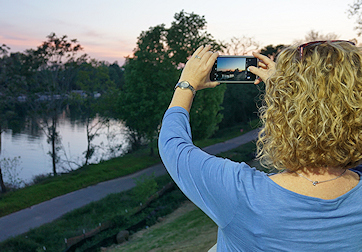 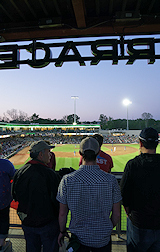 |
| Up on the TaxSlayer Terrace, this scene was being repeated over and over. To say it’s a picturesque spot is a severe understatement. It’s almost as stunning when you’re actually facing the field instead of the river. |
The distance from home plate to the base of the wall down the right-field line is 318 feet. Considering the outfield wall is ten feet tall, that should have created a respectable distance for a batter to clear to earn a home run – especially since the humid river-side air tends to keep the ball from traveling as far.
Minor League Baseball didn’t see it that way.
Eiseman explained that the original intent was for any fly ball that landed over the outfield wall – which is the level of the concourse — was to be a home run. Officials at Minor League Baseball HQ felt that the young pitchers were going to become demoralized after giving up homers to right field. Their solution? Add another fifteen feet. Now to hit a home run to right field, a batter has to reach the base of the Home Run Porch’s floor, which is a whopping 25 feet above the playing surface.
That means that the bright-yellow line that must be cleared takes a bizarre path (see the photo at the top of this page) – from the foul pole across the facing of the HR Porch’s floor, out to the edge of this structure, then down to the level of the concourse (which is in reality the top of the RF wall) – and then on around the rest of the outfield.
I think this is silly – just as it was when Minor League Baseball forced the Hartford Yard Goats to revise their home-run dimensions in right field at Dunkin’ Donuts Park, forcing a batter to clear another 25-foot yellow line along the facing of the upper seating level.
The always upbeat Shultz puts a positive spin on this. “We want a lot of balls to be hit off of this (25-foot wall). We want a lot of doubles and a lot of triples.”
 |
| It was a tricky proposition to position the upper-level seats close to the field without having the bottom of the seating deck encroach on the field seats. They pulled it off, thereby avoiding the “cave effect” that occurs at Nashville’s ballpark. |
The Tax Slayer Terrace isn’t the ballpark’s only allure. Its intimacy is also paramount. “We only have 3,100 seats in the lower bowl,” Shultz points out. “By stretching them all the way down to the foul poles, we’re able to keep from having very many rows. That was an intentional decision.”
And when Shultz wanted to keep the upper-level Club seats from being very far from the field, this worked to the fans’ advantage. “The first row of Club seats is only 26 feet from the grass, putting you right on top of the action. Yes, that’s a tired phrase, but here (the upper-level seats) are the closest of any Minor League park.”
I don’t dispute that, but when First Tennessee Park in Nashville tried to accomplish the same thing, those sitting in the field boxes below felt claustrophobic. And so much light was blocked by the upper level that fluorescent lights had to be attached the underside of the upper deck.
Could that be a problem at SRP Park? “Nope,” Shultz quickly responds. “The upper level only covers three rows (of the field level), so you avoid the ‘cave effect’ that they have in Nashville.” Good.
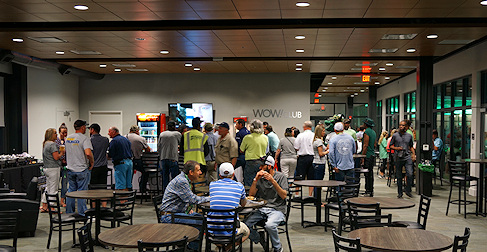 |
| The WOW! Club lounge on the first-base side of the upper level is huge and features a portable bar that can be positioned anywhere in the space. Note the ceiling tiles that give the room a warm look. |
The concourse is both “open” (you can pretty much see the field as you’re walking on it at the rear of the seats) and 360 degrees. Both are massive improvements over Lake Olmstead Park.
The upper level has the feel of a ballpark of a much higher level than Low A, the South Atlantic League’s classification. The private suites are large and well appointed, and the lounge spaces are exceptional. The Wow! Club down the first base line is 3,300 square feet – plus it has a beautiful outdoor patio behind it – reminiscent of the popular cabana areas of The Rooftop deck high atop the right field stands at Coors Field.
Eiseman explained that this Club space should be very popular for groups to rent, and the bar in it is completely moveable, so it can be placed at either end of the area or in the center – however the renter wants it.
In case you’ll ever be a member of the press covering a GreenJackets game, you’ll be happy to know that the pressbox is where it should be (upper level, toward the center) and is sufficiently large (“Compared to the one at Lake Olmstead, it’s the Taj Mahal,” jokes Eiseman). Neither of these were the case at a certain Minor League park that opened last year (we’re looking at you, Dunkin’ Donuts Park!).
At the opposite end of the upper level is another enclosed space behind sections of club seats, and a very special bar.
  |
It’s my favorite aspect of the upper level, although isn’t very large – and it isn’t even air conditioned. The bar tucked between the suites and the enclosed Club area on the 3B side is called the South Carolina State Dispensary (photos above). GreenJackets Community Relations Specialist Shannon Mitchell told me that it takes its name from a store that over a century ago was located exactly where the ballpark is now.
You see, the State of South Carolina came up the hairbrained idea in 1893 that all liquor must be bottled and dispensed at state-operated outlets called Dispensaries. In fact, when the excavation for the lowered playing field was taking place, several bottles from this era were recovered from the ground. Three of these are now displayed at the end of the bar.
That’s quite a fascinating bit of history! And an interesting place to have a drink.
 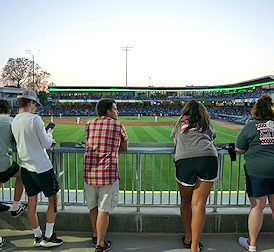 |
| Why didn’t someone think of this sooner? The berm isn’t simply a sloping piece of ground. It’s terraced to make it much more comfortable to sit on. And if you’d rather stand, there are 700 “positions” with drink rails circling the playing field. |
Back downstairs, there are no seats in the outfield, but that doesn’t mean there’s nowhere to watch the game. In fact, there are 700 spots with drink rails all around the field – and these are extremely popular. “We care more about positions than we do seats, because more and more people want to circulate during the game,” explains Shultz.
The only berm area is in foul territory, near the left-field foul pole. Here again, SRP Park does something different, as instead of a gradual slope like everywhere else, the grading for this grass-covered area is tiered, almost like bench seating or bleachers. I’m sure you can’t cram as many bodies into this space as on other berms, but those families parked there will find it much more comfortable. Great idea – one I’m sure that will be copied at future ballparks.
 |
There is a sprawling group area near the right-field foul pole. It’s called the E-Z-Go Picnic Patio (above), and while you can’t really see the river while sitting at one of its tables, you have a great view of the action on the field.
To make all of this work, there was no getting around the fact that the playing surface had to be lower than the street level of the site. Otherwise, you couldn’t have the franchises be viable from both inside and out, and you couldn’t achieve the desired low-profile of the structures.
But Shultz pointed out that this created two issues – many tons of dirt had to be dug out and trucked away, and the high water table of the area had to be kept at bay. Both of these measures created significant cost and took a lot of time.
To keep the lowered field from filling up with H2O due to the water table next to the river, “we essentially had to construct a bathtub all the way around,” Shultz explained. “I mean, what you’re trying to do is keep out Mother Nature, right? But doing it was vital.” And quite expensive.
“Now that the project is coming to fruition, we feel those costs were well, well worth it. As you walk around it and see how it feels nestled in with the lowered field, it was absolutely worth what it took.”
Both aesthetically and functionally, I agree. The fans seem to think so as well.
| Parental view |
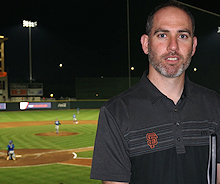 |
| Yeshaya Goldfarb is the VP of Baseball Operations for the GreenJackets’ parent team, the Giants. He likes SRP Park. A lot. “It’s a competitive advantage for us,” he told us. “We want to get our players in the best facilities possible, in front of passionate crowds.” |
While it’s really important to assess what the fans of the Augusta area think about the design of SRP Park, it’s also critical that the GreenJackets’ parent club like what they find. After all, they are footing the bill for the young players who are providing the entertainment that the fans are paying to see.
Goldfarb likes what he found. “It’s everything we ever could’ve wanted. It feels like a home, and it allows the community and the facility to treat our players almost as big leaguers. They’ll be exposed to the kinds of crowds and the atmosphere that they’ll experience in the Majors.” In addition, the angles of the outfield walls exactly match those of AT&T Park in San Francisco, and “we want our young players to get used to that.”
Goldfarb added that the Giants “have been in this community for a long time now and we love it here, and now there’s a facility that matches the community. To have a ballpark like this to represent that fan base is something we’ve been hoping for. It’s pretty special.”
Shultz puts it best in making an overall assessment of SRP Park’s size and amenities: “It all goes back to the feeling of a living room. The metaphors of living room, porch, balcony – we want all of these things to feel natural so that when people walk around here, they’ll say ‘This feels like it belongs here.’ So we want it to feel like a living room – a warm, cozy space.”
A living room with its own porch and a killer view.
The Essentials
The size of SRP Park – with about 4,000 places to sit and could accommodate a crowd approaching 6,000 if necessary – makes perfect sense for a market of Augusta’s population. In other words, it wasn’t overbuilt. As a consequence, it can’t offer the dizzying array of amenities that the largest South Atlantic League park (Spirit Communications Park, 70 miles away in Columbia, SC) can.
But Columbia’s stadium, that can hold 8,500, would be too large for the Augusta area. Further, the grounds of the former state mental hospital in Columbia where the ballpark resides is much larger than Riverside Village, meaning there’s a lot more space for commercial development there. In fact, it will likely top $1 billion when all is said and done — and there are a number of projects currently underway there.
But the fact remains that the ballpark in Columbia and the one in North Augusta are both nice, but SRP Park is simply smaller. As Eiseman points out, “You don’t have to spend $60 or $70 million to have a ballpark that is charming and cool and different. That’s what we were aiming for here.”
And that’s what they got. And the amenities are – or will soon be (once the “franchises” are open) – more than sufficient for the market.
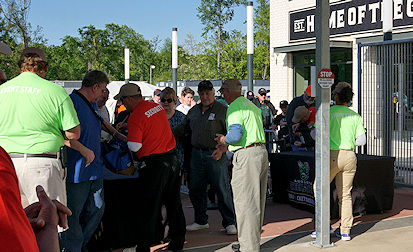 |
| On the beautiful afternoon of April 12, 2018, ushers open the gates of SRP Park to the long line of fans waiting to see the inaugural GreenJackets game in North Augusta. All told, 5,919 attended at the park that normally holds 4,530. |
First, let’s look at the cost of attending a GreenJackets game in their new park. Parking at the garage a block away costs $5 (if it’s not already sold out), although North Augusta is encouraging fans to park up the hill next to the City Municipal Building, and then ride the provided shuttle down to the park’s entrance. Parking in those lots is also $5.
There’s a wide range of ticket prices, but note that several of the upscale seating levels are sold out as season tickets. That’s because four times as many season tickets were sold for SRP Park’s first season than at Lake Olmstead last year. All of the suites are sold out, as are the Club seats on both sides of the upper deck. The Premier Boxes directly behind the backstop – some of which have a countertop in front of your seat (and are called VIP Loge Boxes) – are also sold out.
For many games, the Batter’s Box seats – as you would imagine, they are directly behind the batter’s boxes – are available, at $14 a seat. The Reserved seats behind the dugouts are $10, and the rest of the field-level reserved seats are $9. General Admission tickets are $8 – and remember there are 700 spots with drink rails around the park!
Note that dates with post-game fireworks (typically Saturdays) are $1 higher, and if you wait to buy your tickets until the day of any game, they’ll cost a buck more.
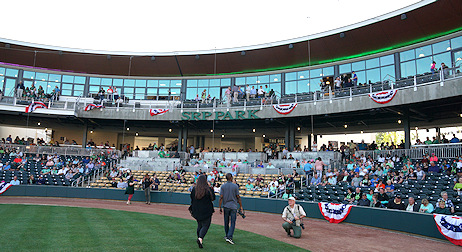 |
| The gold-colored Premier Boxes are shown in the center above, with the VIP Loge Boxes (with countertops) behind them. The green seats on either side are in the Batter’s Box sections. |
In case you’re wondering, these prices tend to be a little higher than at Columbia (e.g., general admission tickets there are just $5, and they don’t charge extra for day-of-the-game purchases), but are still quite reasonable – and are quite a bit lower than at other recently built Southern parks like Biloxi and Nashville.
If you have a group of at least 20 wanting to go to a GreenJackets game, consider the E-Z-Go Picnic Patio that wraps around the right-field corner. For $25 a person, there’s an all-you-can-eat buffet with seating at round or semi-circle-shaped tables.
 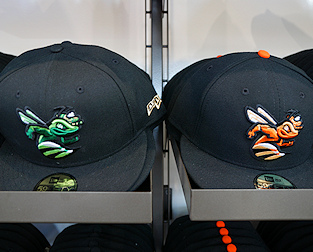  |
Picking up on the “bee” theme of the team’s nickname and mascot, and the fact that The Masters is held just a few miles away, the souvenir store is called The Hive Pro Shop (above). Its high ceilings and tall windows give it a spacious feel. The team went through a re-branding with different colors and logos to coincide with the new park, so there is a multitude of new looks in the apparel.
I couldn’t resist getting a bright-green fitted cap with a raised, embroidered “green jacket” bee rising from the front. It was $30. It also comes with a Giants’ color motif (above). Adjustable caps for adults are $23, while ones for kids are $12.
There is a wide variety of T-shirts, with a wide range of prices ($20-$35). Women’s T’s are $23 and $35, and for kids they range from $13-$20. There were attractive polo shirts, with men’s costing $55, $60 and $70, and women’s $55.
And while some merchandise ties into the fact that the team’s parent club is the Giants, you knew there would be a golfing theme throughout the store. Men’s golf shirts are $55, and bright-plaid golf socks go for $18. There are even GreenJackets golf towels for $8 (above).
And they didn’t let me down when it came to my favorite merchandise item: lapel pins. There were three styles, all for a reasonable $6.
| Jeff out front |
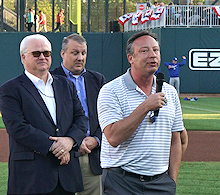 |
| Jeff Eiseman wears multiple hats. As Principal/President at Agon, he oversees the operations of the GreenJackets and the Boise Hawks of the Northwest League. And he does so with a welcome sense of humor. Here he’s addressing the fans on Opening Night at SRP Park. Behind him is Eric Krupa, President of the South Atlantic League, and (in sunglasses) Minor League Baseball President Pat O’Conner. |
The story on concessions isn’t what it will be a few months after the park’s opening. That’s because none of the “franchise” food vendors on the first-base side are open yet – or are even close.
That puts a lot of pressure on the regular concession stands and kiosks. The one Eiseman refers to as “the workhorse” is cleverly called The Back Nine Grill. It’s on the 3B side, and features typical ballpark fare at very reasonable prices (dogs for $4, brats for $4.50, cheeseburger for $6, BBQ sandwich for $6, nachos for $5 and tenders & fries for $7) – as well as two items with a Southern twist: a pimento cheese sandwich ($4) and something called a pimento bacon dog ($7). There’s also a kid’s menu.
This close to Atlanta, you knew this was going to be a Coke (not Pepsi) park. Souvenir-size cups are $6, and 20 oz. domestic beers are $5 and “premium” beers are $6. Can’t complain about those prices at a ballpark.
On the first-base side at the stand called McGavin’s (named, Eiseman told me, for Shooter McGavin, Happy’s rival in the Happy Gilmore movie), you’ll also find a “walking taco” for $4 and a taco basket for $10.
The other two fixed stands also have clever names. They are The Bee-stro near home plate and The Front Nine Grill, located in the right-field corner.
In the left-field corner is a kiosk called The Turn. Since the line tended to be shorter here (and they were really bad on Opening Night, as they always are at a new park), this was where I grabbed a brat.
Once it opens, the most popular eating spot in the park is likely to be Southbound Smokehouse (see photo below), the two-story eatery near the right-field corner that will feature beers from Sweetwater Brewery. And, boy, is it strategically placed. Not only does it have a great view of the river, there’s a walkway from the upper level directly to the TaxSlayer Terrace.
By the way, the Sweetwater Beer Garden was open for the park’s first game. It’s nestled in between the Smokehouse and the ballparks’ first-base structure.
In case your sweet tooth prompts you to start wandering the ballpark, in addition to a couple of Dippin’ Dots stands, there’s a kiosk with frozen lemonade ($5) and funnel cakes ($5) beyond the batter’s eye in center field.
Speaking of the area beyond the batter’s eye, there are covered batting tunnels where fans can watch their favorite players take some hacks. Next to it is where you’ll find inflatables for the kids.
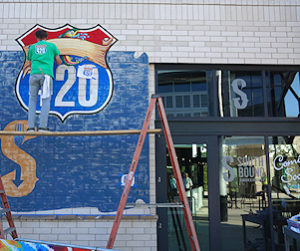 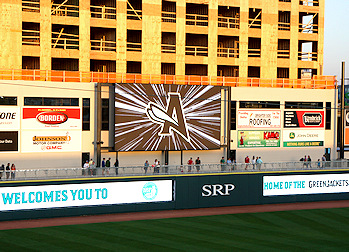 |
Enhancing the gameday atmosphere, of course, are the sights and sounds of a ballpark. The sound system at SRP Park is top-notch – and not overwhelming if you happened to be close to one of the many speakers.
Visually, the park is a treat for many reasons – not the least of which is the 42’-by-22’ video board beyond left center. In addition are two 6’-by-80’ and two 6’-by-20’ video screens embedded into the outfield walls (photo above). “Only one video board was never going to do it for me,” admitted Eiseman.
Another visual treat are LED lights strung along the underside of the roof of the ballpark. They are computerized and can change color in fascinating patterns.
And I’d be remiss if I didn’t mention the LED lights on top of the towers. These not only illuminate the field using far less energy than incandescent bulbs, they can also be programmed to go on and off independently … and can actually twinkle like stars.
Once there are more food choices and the concession lines get shorter, this will be one of the better gameday experiences in the Minors.
Summary
 |
Indeed, SRP Park is as cozy as a living room. But how does it stack up with other ballparks at this level?
As mentioned, it’s natural to compare it to Spirit Communications Park in Columbia, SC – although any comparison or ranking is subjective. To me, Columbia and Fort Wayne are still the top two parks in Low A baseball, but neither have the picturesque setting or intimacy of SRP Park.
Overall, I would put SRP in the top four of the 30 Low A ballparks, joining Columbia, Fort Wayne and Great Lakes. That is some exceptional company.
Comparing the construction costs of various parks isn’t a valid exercise. Spending more money doesn’t necessarily mean you get more ballpark, because complications at the site can add greatly to the cost. The site in Columbia, for instance, was fairly favorable, and that allowed a tremendous park to be built for $37 million. In North Augusta, they had to build the so-called “bathtub” around the entire field because of the high water table next to the river. That, and all of the digging to lower the field, added greatly to the cost at SRP.
So how much did SRP Park cost to build anyway? “I guess the total is $41 or $42 million,” Eiseman chuckled. “I’ve stopped counting because it’s just an ulcer waiting to happen.”
The ballpark’s financing worked like this. The team paid $1 million upfront, and the City financed the remaining cost and now owns the stadium. The GreenJackets will make lease payments of approximately half a million dollars a year, and the City and team had a mutually agreeable approach to paying for cost over-runs on the construction. “As the ‘master tenant,’ we are the Schneider of the One Day At A Time TV show,” Eiseman explained colorfully. “We’re the one with the big set of keys.” Put another way, the team is responsible for the park’s maintenance and repairs.
He went on to add insight to the City’s role in the overall Riverside Village. “A project like this is so massive for a smaller municipality and carries risks, that it terrifies some of the residents, especially the ones who get their news from blogs and Facebook. (For them) it creates its own echo chamber.
“But the City took this on in a very responsible way,” he continued. “This wasn’t ‘If we build it they will come.’ No, if there weren’t certain commitments from businesses, the City wasn’t releasing the bonds.” He added that North Augusta incorporated safeguards in the contracts that require the developer to make up any shortfalls in property taxes generated from the project versus what was anticipated.
Smart.
 |
SRP Park is certainly an aesthetic triumph, and from the GreenJackets’ first pitch in their northside digs (shown above), the fans and players have enjoyed it immensely.
But how is it working financially for the team?
Eiseman noted that Minor League franchises obtain revenue from five sources: tickets; sponsorships; food and beverage; merchandise and events/rentals. He explained that no food vendor was willing to take any risk due to the presence of the outside food “franchises” in the park, so the GreenJackets are operating the concessions themselves. This is certainly an unusual scenario since there will be outside vendors selling food.
“We’re either going to be geniuses for being able to figure out something that no one has been able to, or we’re going to be idiots for trying this.”
As for the other four sources of revenue, things are looking up. “I’d say baseball in Augusta has been a break-even proposition over the past 30 years. A lot of years, we were operating as a non-profit entity even though the Government hadn’t approved that (designation). Rather than leave the area for greener pastures, we truly believed this market hadn’t been given the opportunity to flourish because Lake Olmstead lacked what it should have to present this sport on the stage it deserves. This was the belief we placed our bet on.
“Now that it’s coming to fruition, we’re knocking it out of the park,” Eiseman continued. “Our season-ticket base is now four times what it was at Lake Olmstead. Our sponsorships have more than doubled. Before we even played a game (at the new park), our group sales have exceeded what we did the entire season last year.”
So things are going well since moving north. And they are doing so in a comfortable living room with an unbeatable view.
Let everyone know what you think of SRP Park — as well as this review — in the comments area below.